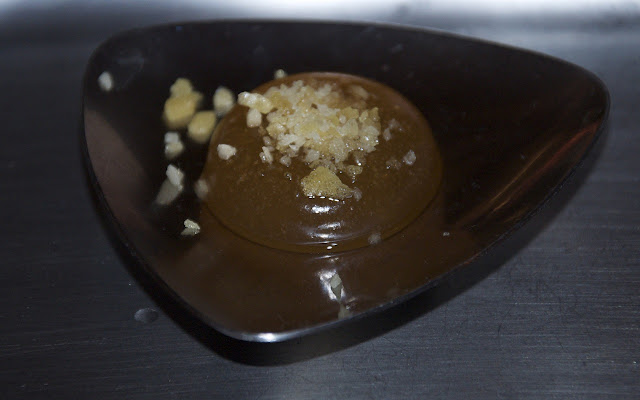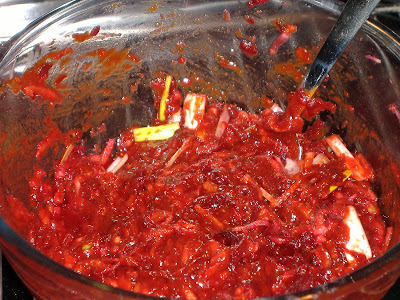Molecular gastronomy is a bit of a fancypants name, and not one I like very much; every generation has it's creative and inquisitive food-and-drink obsessives and ours seem to have taken on this label for their endeavours. You could certainly label Paul creative and inquisitive, I've written about the drinks at his bar Lounge Bohemia before, I wouldn't presume to call him obsessive but it wouldn't surprise me after seeing this evening's line-up. Ben is a chef with a very impressive list of restaurants on his CV including Noma in Copenhagen and the Momofoku restaurants in New York.
To start, we were greeted with a 'palate cleanser' of black-pepper infused vodka with elderflower cordial and lemon juice as introductions were made and we chatted with our fellow diners. Expertly judged it certainly cleansed the palate and whet the appetite, it would also prove to be the only drink of the night that you'd pick out as a cocktail in an identity parade. Anticipation was high as we took our seats.
Our first course was a G&T (of course!) this was cucumber infused gin with quinine cordial and carbon dioxide set into rather beautiful crystalline-looking, wobbly jellied cubes. These had a remarkable fizz on the tongue as you bit into them, cleverly recreating the G&T in your mouth with the bitter quinine finish and a pleasing alcoholic kick too.
This was paired with an oyster, topped with buttermilk and a rhubarb granita. Oysters are something I hate to see people fannying about with but this worked surprisingly well to my mind, the granita dissolving quickly and coldly in the mouth, leaving the creamy oyster and buttermilk behind.
Next up was a cocktail of 'Caviar', little balls of mango infused vodka with mango juice and rose syrup...
...which was paired with grilled prawns and caramelised mango, the prawns beautifully sweet with a charred smokiness.
Then an entertaining swipe at recreating the classic champagne cocktail: a glass of Chardonnay and brandy, sweetened with sugar and angosturas bitters was served with 'fizzy grapes': grapes infused with brandy and bitters. We were instructed to put one of the grapes in our mouth before taking a sip of the drink and then biting into the grape, and a lot of fun it all was too. The grapes themselves were quite amazing, infused and marinated into something very different in both taste and texture, I'd buy jars of them if I could.
This was matched with a roasted scallop with pickled grapes and pistachio. The grapes here were more like umeboshi plums after Ben had finished pickling them in red wine vinegar, the scallop thick, sweet and perfect.
Next up was a cocktail of 'Japanese light lunch', cucumber chunks infused with vodka, 'soba noodles' made from poppy seed and biscuit infused vodka and a black pepper infused vodka with wasabi. The cucumbers tasted extremely alcoholic and somewhat harsh, the noodles the opposite although the reverse was true, we were informed. We were instructed to down the little pot of vodka and wasabi in one. I've eaten a lot of Japanese food but I've never had a lunch that left me feeling I'd just been punched in the face.
This came with a piece of salmon and three different types of radish, the salmon cooked sous vide with soy and sesame giving it a remarkable, soft texture that was delicious but I'm struggling to describe it without making it sound gross so I'll stop trying.
Campari and soda was next, a fluffy ball of campari candy floss that you bundled into your mouth followed by a swig of club soda and then sit there looking wide-eyed at your dining companions whilst a party rages in your mouth.
Followed by a piece of mackerel with fennel and blood orange. The little fennel flower with this really sticks in my mind, such a delicate little tiny thing, it packed a real punch of fennel flavour.
Then a margarita - tequila, lime juice and agave syrup that had been turned into one big foam and was served in dainty little cut-out limes.
A dish of quail and coriander with an intense, delicious sweetcorn puree. At this point we needed to open the main door for a few minutes, I think cooking the prawns and the quails had proved a bit too much for the domestic-standard extraction hood in the open-plan kitchen.
Now it was time for "cleaning the teeth", a toothpaste tube of minted rum, green peas and a white chocolate liquer. You pierced the silver foil of the tube and just squirted it all into your mouth, I wish I'd taken more photos here of (a) everyone trying to drink this and (b) what the drink actually looked like. It was green. Whilst we were all speculating how Paul got the drink into the tube our accompanying dish of yoghurt, whey and mint oil arrived - pretty as a picture to look at, beautifully rich and textured yet light and refreshing at the same time. It seems to be the one thing I didn't get a photo of, a great shame since it was probably my favourite of the evening which is praise indeed given the quality overall.
We then got the night's biggest single piece of theatre as Paul prepared the Bohemian Breakfast for us at the end of our table. Setting fire to the contents of a metal jug he stood pouring the flaming contents steadily into another metal container as he calmly stirred and adjusted the fiery flow, once that was over he asked us how we'd like our eggs cooked. Before anyone could answer he was cracking one on the rim and stirring the contents in. The big trick is that we were all expecting a warm, gooey, half-cooked eggy slop in our glass and of course it was stone cold with no egg in sight. As the drinks were served an amused looking Paul realised he was going to have to spell it out to us that it wasn't actually egg that was in the egg that he cracked. This was a Black Forest ham infused bourbon(!!) with advocaat, maple syrup and condensed milk.
The Bohemian Breakfast was accompanied by a toasted brioche with Wigmore cheese, the cheese grated incredibly finely and piled high taking on almost a whole new texture and going perfectly with the sweet toasted bread. This was many people's favourite dish of the night.
Turning the corner into the finishing straight now and it's the salty caramel next: a shot glass containing Werther's Original infused vodka(!) with dark creme de cacao, condensed milk and honey. The foam on top was very salty, hitting your mouth just before the sweet caramel follows through. We were instructed to throw the whole glass back in one go although I seem to remember half the table had already done that before being told.
This came with pear and caramel brown butter and toasted flakes.
Next up was a White Russian, a vodka and cream marshmallow in a coffee liquer.
Accompanied by seabuckthorn & gingerbread. The seabuckthorns are little yellow berries that Ben had acquired in Copenhagen and these were delicious, he brought out a bowl of raw ones for us to try since we were all obviously very taken with them. I don't know what he did he to cook them (it's very possible that he did tell me at the time and I've just erm, forgotten) but they were certainly transformed from the tart rather sour little things they are in their raw state.
Romping past the finish line saw Paul's final cocktail of the night - Amaretti biscuits. Biscuit infused vodka with amaretto topped with "effervescent sugar" which caused everyone at the table, as soon as they tried it, to try and say "oooooh! Space dust!!" whilst their mouths were popping furiously.
This came with a very soothing coffee milk and amaretto. Phew! And with that we were all left to finish chatting and comparing notes, swapping numbers and emails and trying to work out the best way home, time had flown and we were all surprised at how it had got so late so quickly.
I was surprised how excellent the food was, I was expecting something more along the lines of a few dishes to keep the booze-hounds happy whilst we ploughed through the cocktails but Ben had put a lot of thought and effort into matching everything Paul had got to throw at him, he's clearly a talented guy. I don't know what his plans are when his stint at the Loft is over, but he's a chef to look out for in the future.
It all added up to a very special evening indeed, the cocktails created and served with a wit and microscopic attention to detail along with the obvious creativity and intelligence behind them, it's hard to describe the kind of atmosphere and expectation that gets built up. Suffice to say the next morning was a major disappointment when my cappuccino tasted exactly like a cappuccino and didn't do anything special and my breakfast tasted just how it looked, no popping, fizzing, no surprises, not even a punch in the face.
Paul does (smaller) tasting menus of molecular gastronomy cocktails at Lounge Bohemia, contact details on their website, I've also got an earlier post about them.
MsMarmiteLover has a post on the evening along with more about Ben's cooking on her entertaining blog.
































